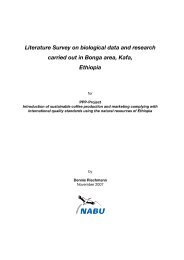Flora Biodiversity Assessment in Bonga, Boginda and Mankira Forest
Flora Biodiversity Assessment in Bonga, Boginda and Mankira Forest
Flora Biodiversity Assessment in Bonga, Boginda and Mankira Forest
Create successful ePaper yourself
Turn your PDF publications into a flip-book with our unique Google optimized e-Paper software.
Chaffey reported that <strong>in</strong> Kaffa prov<strong>in</strong>ce (which used to cover a larger area than now)<br />
there were six sawmills among which Jimma Plywood Factory was one. 90 percent of the<br />
raw material <strong>in</strong>put for this plywood factory was reported to be Pouteria adolfi-friederici.<br />
Kaffa forests used to supply an amount of 28,000m 3 round timbers every year (Chaffey,<br />
1979). Major species logged dur<strong>in</strong>g the period <strong>in</strong>clude (Chaffey, 1979): Pouteria adolfifriederici,<br />
Apodytes dimidiate, Cordia africana, Croton macrostachyus, Ekebergia<br />
capensis, Hagenia abyss<strong>in</strong>ica, Prunus africana, Olea aricana, Olea welwitschii,<br />
Polyscias fulva, Olea capensis <strong>and</strong> Syzygium gu<strong>in</strong>eense.<br />
Upper storey species recorded by Getachew Berhane <strong>and</strong> Yoseph Assefa <strong>in</strong> IBC 2002 <strong>in</strong><br />
Bog<strong>in</strong>da forest are: Pouteria adolfi-friederici, Prunus africana, Syzygium gu<strong>in</strong>eense,<br />
Polyscias fulva, Croton macrostachyus, Bersama abyss<strong>in</strong>ica, Schefflera abyss<strong>in</strong>ica,<br />
Macaranga capensis <strong>and</strong> Bersama abyss<strong>in</strong>ica.<br />
Understorey tree species that can atta<strong>in</strong> up to 30 cm dbh, but typically smaller accord<strong>in</strong>g<br />
to Chaffey, are recorded. These <strong>in</strong>clude Allophyllus macrobotrys, Psychotria orophila,<br />
Vernonia sp <strong>and</strong> Rytigynia neglecta .They are similar to the species identified <strong>in</strong> the<br />
work of Chaffey. Coffea arabica occurs naturally as an understory shrub at elevation<br />
between about 1000 <strong>and</strong> 1800 masl (Chaffey, 1979).<br />
Friis, 1992 recorded 25 species of lianas, <strong>and</strong> numerous species reported as epiphytes<br />
<strong>in</strong>clud<strong>in</strong>g ferns, lycopods, orchids, Peperomia (Piperae.), <strong>and</strong> Scadoxus nutants<br />
(Amarylliadac.). He <strong>in</strong>dicated how the undergrowth is very rich where he claimed to<br />
record more than 110 species.<br />
4.3.2. Stem per hectare <strong>and</strong> number of species<br />
On average with<strong>in</strong> the three strata the number of stems per hectare recorded <strong>in</strong> this study<br />
is 586 for <strong>Bonga</strong>, 562 for Bog<strong>in</strong>da <strong>and</strong> 454 for <strong>Mankira</strong>, whereas, Chaffey has estimated<br />
stems per ha for all species hav<strong>in</strong>g diameter greater than 30 cm <strong>and</strong> found out 125.<br />
Lamprecht, 1989, quot<strong>in</strong>g Veillon, 1976 has reported stem per ha hav<strong>in</strong>g diameter 10 cm<br />
<strong>and</strong> above for Venezuelan cloud forest (montane) as 745. Getachew Berhane <strong>and</strong> Yoseph<br />
46



